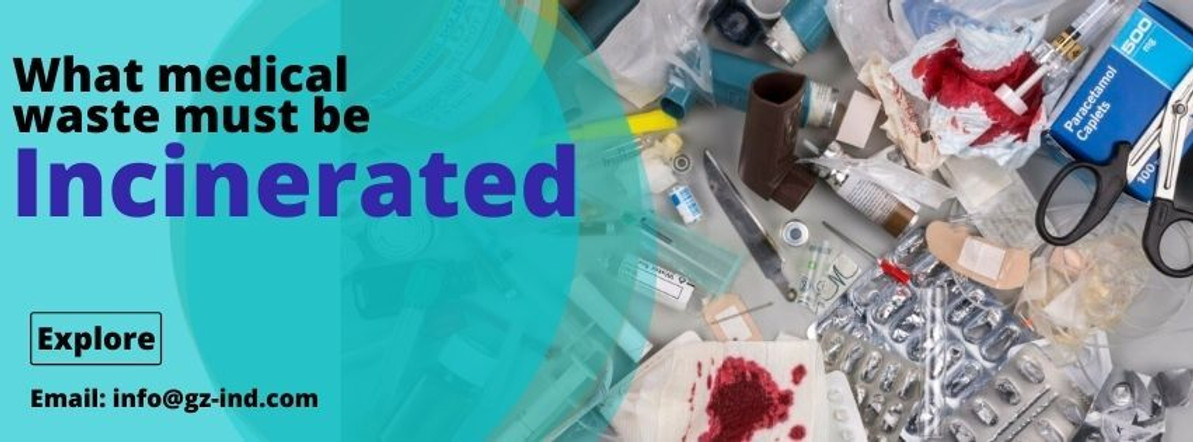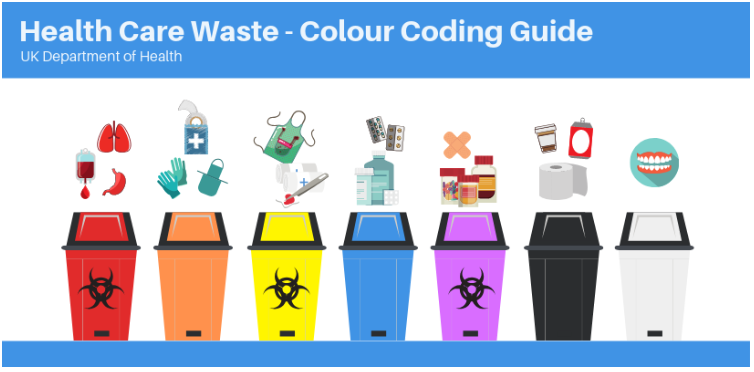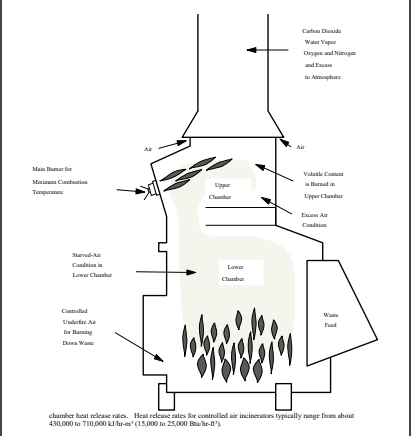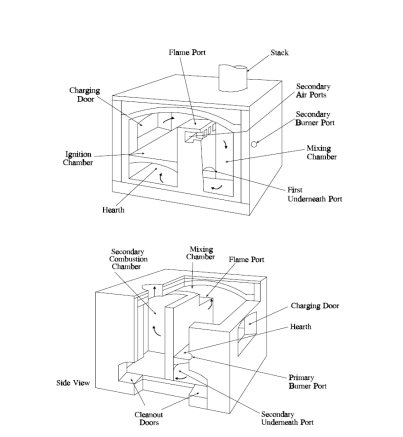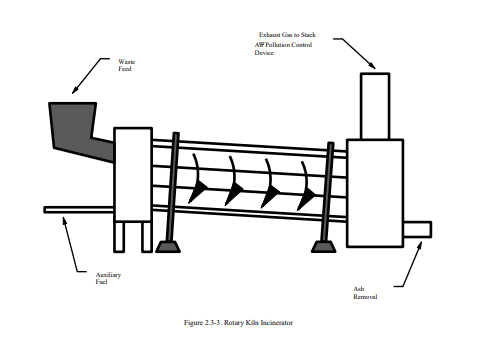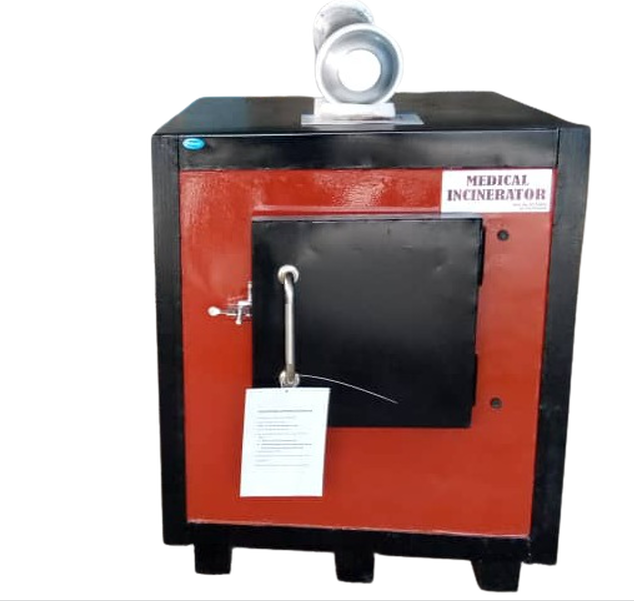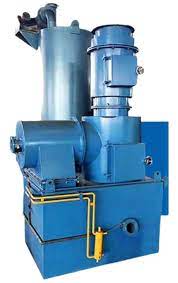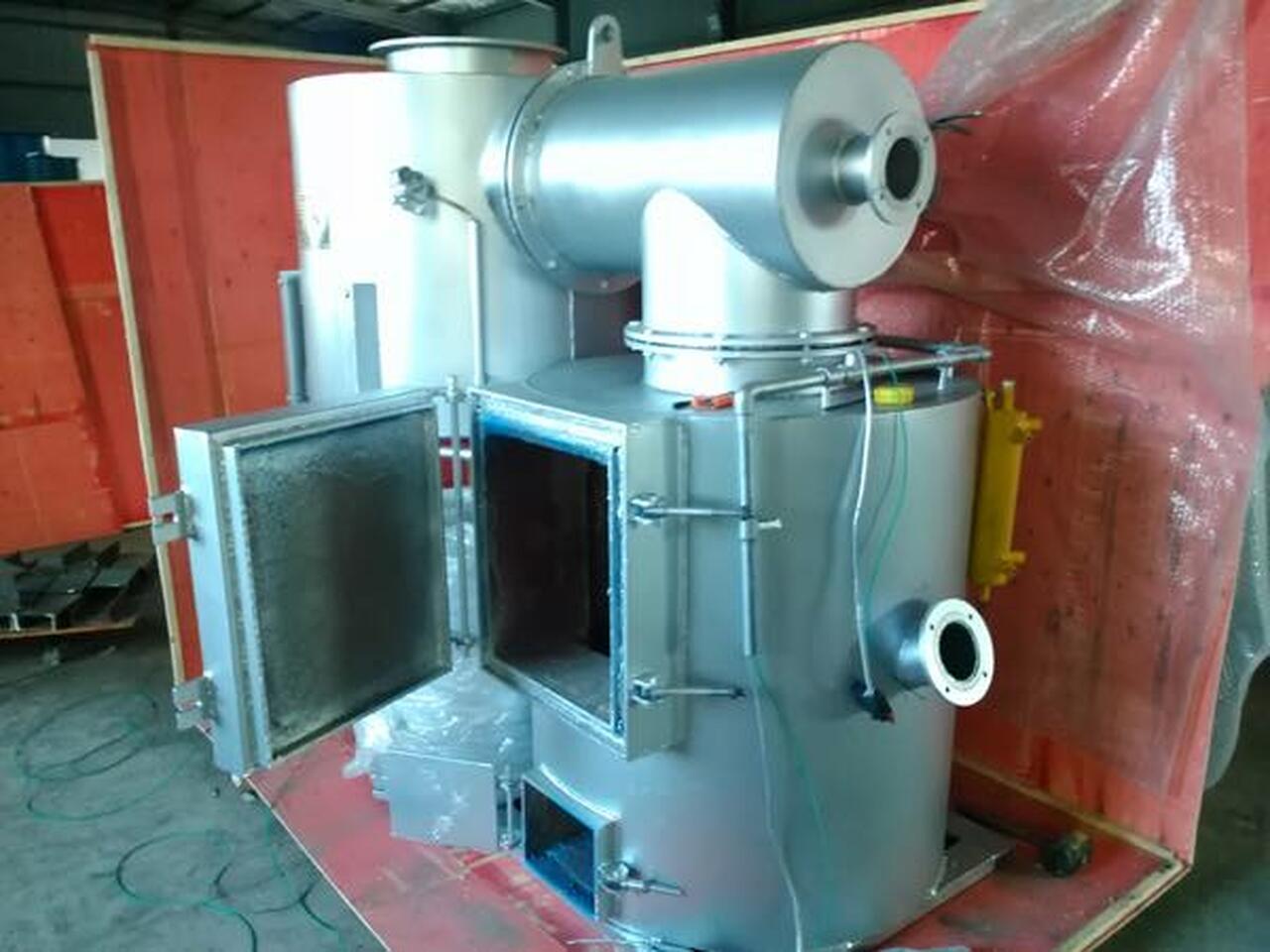What medical waste must be incinerated?
Medical wastes are disposed of in several ways, such as incinerating, autoclaving, microwaving, and chemical disinfecting; choosing the suitable waste to be incinerated helps reduce the degree of toxic substances like dioxins released into the atmosphere, which cause cancer.
Most medical establishments unconsciously practice poor waste management, which is an ineffective way of disposing waste because it leads to air pollution and soil/ water contamination. These practices also tend to put children, adults, and animals at risk when they contact such waste and could pose a potential health risk. The waste could lead to wildlife and aquatic endangerment, and the solutions to these issues like proper identifications of the type of waste needed to be incinerated to prevent the pose of harm to earth are of top-most importance.
The practice of proper medical waste management will make our environment conducive for living and reduce environmental problems like soil and water contamination. Kindly read on to identify the type of medical waste to be incinerated.
Table of content
- What are Medical Waste
- Types of Medical waste
- Health risk of medical waste
- How are medical waste regulated?
- What is incineration?
- Incineration process
- Types of Medical incinerator
- Medical waste that should be incinerated
- How medical waste should be incinerated
- What happens when the wrong choice of waste is incinerated
- Available incinerators
- Maintenance of medical incinerator
- Where to buy medical incinerator
- About GZ Industrial supplies
- Conclusion
What are Medical waste?
Medical wastes are generated as a result of patient diagnosis and/or treatment or the immunization of human beings or animals. The subset of medical waste that potentially could transmit an infectious disease is termed infectious waste.
The Centers for Disease Control (CDC), the U.S. Environmental Protection Agency (EPA), and the World Health Organization (WHO) concur that the following wastes should be classified as infectious waste: sharps (needles, scalpels, etc.), laboratory cultures and stocks, blood and blood products, pathological wastes, and wastes generated from patients in isolation because they are known to have an infectious disease. Medical wastes can also include chemicals and other hazardous materials used in patient diagnosis and treatment. In some cases this subset of medical waste is classified as hazardous waste. Hospitals, clinics, research facilities, diagnostic labs, and other facilities produce medical waste. The bulk of the wastes generated by most health care facilities, however, is municipal solid waste (MSW), or trash. MSW includes large quantities of paper, cardboard and plastics, metals, glass, food waste, and wood. Medical waste, though a smaller portion of the total health care waste stream, is of special concern because of the potential hazards from pathogens that may be present, or from hazardous chemicals.
Red – anatomical (Organs, blood)
Blue – (unused drugs) medicines
Purple – cytotoxic and cytostatic products (e.g., chemotherapy medicines)
Black – municipal waste –not clinical or medical waste
White – dental
Orange – infectious/clinical
Yellow –highly infectious/ clinical
Types of Medical Waste
According to World Health Organization, the total amount of waste derived from healthcare activities is about 85%, non-hazardous waste comparable to domestic waste. The remaining 15% is considered hazardous material that may be infectious, chemical, or radioactive.
Healthcare activities protect and restore the health of the citizens and save lives. But what about the waste and by-products they generate?
- Infectious waste: This type of waste is often contaminated with blood and other bodily fluids, so workers in the healthcare field take extra precautions to avoid infection, for example ( discarded diagnostic samples), stocks of infectious agents from laboratory activities, and cultures such as infected animals from laboratories and autopsies), or waste from patients with infections (such as bandages, swabs, and medical devices that are disposable ).
- Pathological waste: human tissues, organs or fluids, body parts, and contaminated animal carcasses;
- Sharp waste: syringes, blades, needles, disposable scalpels, etc
- Chemical waste: The chemical waste, solvents, and reagents usually used for laboratory preparations, disinfectants, sterilants, and heavy metals contained in medical devices such as mercury in broken thermometers) and batteries should also be incinerated
- Pharmaceutical waste: This includes expired, unused and contaminated drugs and vaccines.
- Cytotoxic waste: Waste that is referred to as cytotoxins waste contains substances with genotoxic properties that are highly hazardous( mutagenic, carcinogenic, teratogenic, or ). The drugs that are cytotoxic are used in cancer treatment, and their metabolites are inclusive.
- Radioactive waste: Wastes that are contaminated by radionuclides such as radiotherapeutic materials and radioactive diagnostic material.
- Non-hazardous or general waste: This type of waste does not by any means pose any particular radioactive, biological, physical hazard, or chemical.
Let's see below the primary sources of medical waste;
- hospitals and other health facilities
- animal research and testing laboratories
- mortuary and autopsy centers
- blood banks and collection services
- laboratories and research centers
- nursing homes for the elderly
Research has also shown that High-income countries generate on average up to 0.5 kg of waste that is hazardous per hospital bed per day, while low-income countries generate on average 0.2 kg. However, medical waste is not usually separated into hazardous or non-hazardous wastes in low-income countries, making the real quantity of hazardous waste much higher.
Health risks of Medical Waste
Medical waste contains potentially harmful microorganisms that can infect hospital patients, health workers, and the general public. Other potential hazards may include drug-resistant microorganisms which spread from health facilities into the environment.
Adverse health outcomes associated with health care waste and by-products also include:
- sharps-inflicted injuries;
- toxic exposure to pharmaceutical products, in particular, antibiotics and cytotoxic drugs released into the surrounding environment, and to substances such as mercury or dioxins, during the handling or incineration of health care wastes;
- chemical burns arising in the context of disinfection, sterilization, or waste treatment activities;
- air pollution arising as a result of the release of particulate matter during medical waste incineration;
- thermal injuries occurring in conjunction with open burning and the operation of medical waste incinerators; and
- Radiation burns.
How are Medical Waste Regulated?
Due to the detrimental effect of poor waste management, various bodies have been set up to curb such practices by setting up regulations to govern the storage, transportation, labeling, handling, treatment, and disposal of medical waste, and they include
- OSHA: They give guidelines for worker safety, waste labeling, and handling.
- Department of Transportation (DOT): This body sets rules for the packaging and transportation of wastes
- Nuclear Regulatory Commission (NRC) radioactive waste: They are in charge of setting regulations for standard management practices.
- Resource Conservation and Recovery Act (RCRA): They govern the proper management of hazardous waste and material, such as pharmaceutical wastes that are hazardous.
- Drug Enforcement Agency (DEA): They are responsible for setting regulations in the handling and disposing of controlled substances such as narcotics.
- The Clean Air Act: This body regulates and monitors the emissions from incinerators, and it gives a direction on the right type of disposal to practice, that is, what may be disposed of down the drain.
- The state environmental and health: They set rules that help define the various types of waste and determine specifics of waste treatment, as well as requirements for storage, labeling, handling, and segregation.
What is Incineration?
This can be defined as any waste treatment process that involves the combustion of substances contained in waste materials. In comparison, Medical waste incineration is a process that involves the ignition of waste that is produced from the activities in the hospitals, research facilities, and veterinary facilities, such as both infectious and non-infectious medical waste and general housekeeping wastes.
Incineration Process
The incineration process is a waste management process that involves the combustion of medical waste materials. It undergoes so many steps like waste preparation, combustion, energy recovery, environmental control, and environmental release. Incineration has the capacity to reduce the volume of the waste to about 80-85%. The incineration process can also be used for energy generation; the gases can be extracted and used to generate electricity.
Types of medical Incinerator
There are three major types of incinerators used for medical purposes and they include controlled air, excess air, and rotary kiln. Amongst the three types of incineration, studies have shown that the majority of incinerators are controlled air units (>95 %). While a small percentage (<2 %) is excess air incinerator, less than 1 percent was identified as a rotary kiln. The rotary kiln units tend to be larger and typically are equipped with air pollution control devices.
Controlled-Air Incinerators
This type of incinerator is widely used as medical waste incinerator (MWI) technology, and it currently dominates the market of new systems at hospitals and similar medical facilities. It is also known as starved-air incineration with two-stage incineration or modular combustion.
In the first stage, the medical waste is placed into the primary, or lower combustion chamber, which is usually operated with a stoichiometric amount that is lower than the required air for combustion. When the Combustion air goes through the lower or primary chamber from beneath the incinerator hearth (below the burning bed of waste). This air is called primary or under-fire air. In the primary (starved-air) chamber, the low air-to-fuel ratio dries and facilitates volatilization of the waste, and most of the residual carbon in the ash burns. In these conditions, the combustion gas temperatures are relatively low (760 to 980C [1,400 to 1,800F]).
In the second stage, excess air is added to the volatile gases formed in the primary chamber to complete combustion. Secondary chamber temperatures are higher than primary chamber temperatures-- typically 980 to 1,095C (1,800 to 2,000F). Depending on the heating value and moisture content of the waste, additional heat may be needed. This can be provided by auxiliary burners located at the entrance to the secondary (upper) chamber to maintain desired temperatures. Waste feed capacities for controlled air incinerators range from about 0.6 to 50 kg/min (75 to 6,500 lb/hr) (at an assumed fuel heating value of 19,700 kJ/kg [8,500 Btu/lb]). Waste feed and ash removal can be manual or automatic, depending on the unit size and options purchased. Throughput capacities for lower heating value wastes may be higher since feed capacities are limited by primary.
Due to the low air addition rates in the primary chamber and corresponding low flue gas velocities (and turbulence), the amount of solids entrained in the gases leaving the primary chamber is low. Therefore, the majority of controlled air incinerators do not have add-on gas cleaning devices.
Excess Air Incinerators :
They are typically small modular units. They are also referred to as batch incinerators, multiple chamber incinerators, or "retort" incinerators. Excess air incinerators are typically compact cubes with a series of internal chambers and baffles. Although they can be operated continuously, they are usually operated in a batch mode. The Figure presents a schematic for an excess air unit. Typically, waste is manually fed into the combustion chamber. The charging door is then closed, and an afterburner is ignited to bring the secondary chamber to a target temperature (typically 870 to 980°C [1600 to 1800°F]). When the target temperature is reached, the primary chamber burner ignites. The waste is dried, ignited, and combusted by heat provided by the primary chamber burner, as well as by radiant heat from the chamber walls. Moisture and volatile components in the waste are vaporized and pass (along with combustion gases) out of the primary chamber and through a flame port which connects the primary chamber to the secondary or mixing chamber. Secondary air is added through the flame port and is mixed with the volatile components in the secondary chamber.
Burners are also installed in the secondary chamber to maintain adequate temperatures for the combustion of volatile gases. Gases exiting the secondary chamber are directed to the incinerator stack or to an air pollution control device. When the waste is consumed, the primary burner shuts off. Typically, the afterburner shuts off after a set time. Once the chamber cools, ash is manually removed from the primary chamber floor, and a new charge of waste can be added. Incinerators designed to burn general hospital waste operate at excess air levels of up to 300 percent. If only pathological wastes are combusted, excess air levels near 100 percent are more common. The lower excess air helps maintain a higher chamber temperature when burning high-moisture waste. Waste feed capacities for excess air incinerators are usually 3.8 kg/min (500 lb/hr) or less.
Rotary Kiln Incinerators -
They are also designed with a primary chamber, where waste is heated and volatilized, and a secondary chamber, where the combustion of the volatile fraction is completed. In this type of incinerator, the primary chamber comprises a slightly inclined, rotating kiln in which waste materials migrate from the feed end to the ash discharge end. The waste throughput rate is controlled by adjusting the rate of kiln rotation and the angle of inclination. Combustion air enters the primary chamber through a port. An auxiliary burner is generally used to start combustion and maintain desired combustion temperatures. Both the primary and secondary chambers are usually lined with acid-resistant refractory brick, as shown in the schematic drawing,
Figure 2.3-3. Volatiles and combustion gases pass from the primary chamber to the secondary chamber. The secondary chamber operates with excess air. Combustion of the volatiles is completed in the secondary chamber. Due to the turbulent motion of the waste in the primary chamber, solids burnout rates and particulate entrainment in the flue gas are higher for rotary kiln incinerators than for other incinerator designs. As a result, rotary kiln incinerators generally have add-on gas cleaning devices.
Medical Waste that should be incinerated
Not all types of medical waste will be incinerated because of the problem of poor waste management in a world where we have an issue of global warming and environmental degradation. Selecting the proper waste to be incinerated would help to reduce the issue of environmental problems.
- Non-hazardous waste like plastics, because they do not contain toxic substances, which after when incinerated, would not release harmful substances into the atmosphere.
- Pathogenic waste can be disposed of using the incinerator due to the high working temperature of about 800 -1200 degrees centigrade; all microorganisms are destroyed at this temperature. The fear of having an outbreak would not be a problem.
- Sharps are also incinerated. They are surgical instruments; examples are injections, scalpels, and plastics. These can be infectious, which means incineration of sharps can help destroy these diseases.
How Medical Waste Should be Incinerated
The substances contained in the medical waste or areas of the medical industries where they are used.
- Segregation of the waste should be done first before incinerating.
- The type of chemicals that should be incinerated must be determined first because of releasing toxic substances into the environment.
- The waste from surgical units which are known to be infectious should be incinerated to destroy the microorganisms in the waste.
What happens when the wrong choice of waste is incinerated
- Chemical waste like mercury which is a heavy metal that, when it is released into the environment, can be harmful.
- Radioactive wastes are very hazardous and dangerous. They could cause cancerous growth and genetic mutation in humans.
- Dioxins are an air pollutant that causes problems with reproduction, development, and the immune system. They can also disrupt hormones which can lead to cancer.
- Basically, all these other effects affect the nation's economy. When there are disease outbreaks, the nation's economy can be affected by treating the sick.
- Causing extreme climate changes in the environment. The earth is getting warmer, which has led to a flood increase.
- The planet is slowly dying.
Medical/ Industrial Incinerator
Tikweld welding supplies and services is a distributor and supplier of medical equipment in Nigeria. Our Medical and hazardous waste incinerator is an equipment well suited for burning syringe, paper waste, bandages, absorbent cotton and other Medical wastes . It has high burning efficiency, high degree of environmental safety. it is an ideal choice for waste treatment of Hospital, Hotels and other Industries.
Technical Specifications of Medical Waste Incinerator Hellog
- Burn Rate: Up to 20Kg per hour
- capacity : 280kg
- Average Fuel Consumption: 7-9 Ltr p/h
- Operational Temperature: > 850c
- Average Ash Residue (1%): 3%
- Thermostatic Device: Yes
- External Width (mm) 660mm
- External Height (mm): 4310mm
- Door Size (mm): 490x 490mm
- Weight: 50Kg
Features of Medical Waste Incinerator Hellog
- Cladded for heat retention, cool touch and hygiene control
- Rapid, complete and efficient medical waste disposal
- Patented safety handle for easy access to chamber
- High quality refractory lining and insulation
- Fast pre-heat and continual high temperature performance
Smokeless Medical Waste Incinerator - Hellog
GZ Industrial Supplies is a distributor and supplier of Hellog tools in Nigeria. Our Smokeless Medical waste Incinerator. It is an equipment well suited for burning syringe, paper waste, bandages, absorbent cotton and other Medical wastes . It has high burning efficiency, high degree of non-harm, it is an ideal choice for waste treatment of Hospital, Hotels and other Industries.
Technical Specifications of smokeless Medical Waste Incinerator
| Model Number | Dimensions (L*W*H) mm | Power Supply | Induced Draft Fan |
| YFS30 | 1300*900*2900 | 380V or 220V | 0.37KW |
| YFS50 | 1500*1100*3000 | 380V or 220V | 0.37KW |
| YFS150 | 2000*1400*3500 | 380V or 220V | 0.55KW |
| YFS300 | 2200*1600*3800 | 380V or 220V | 0.75KW |
| YFS500 | 3000*2000*4800 | 380V or 220V | 1.1KW |
| CYFS-30 | 1100*850*1100 | 220V | 0.75KW |
Features of smokeless Medical Waste Incinerator
| Burner Specification | Fuel | Dosage | Chimney (mm) | Weight (Kg) | Incineration Quality (kg/time) |
| 0.11 KW, 200000 calories | Diesel, natural gas, liquefied gas | 4 – 6 | Ჶ280 | 2300 | 30 – 50 |
| 0.11 KW, 200000 calories | Diesel, natural gas, liquefied gas | 5 – 10 | Ჶ280 | 4000 | 50 – 80 |
| 0.22 KW, 400000 calories | Diesel, natural gas, liquefied gas | 8 – 15 | Ჶ300 | 7000 | 100 - 200 |
| 0.33 KW, 600000 | Diesel, , natural gas, liquefied gas | 10 – 25 | Ჶ350 | 8000 | 200 – 400 |
| 0.44KW, 800000 | Diesel, , natural gas, liquefied gas | 20 – 30 | Ჶ430 | 13000 | 300 - 600 |
| 0.15kW, 300000 | Diesel | 4 – 8 | Ჶ280 | 540 | 30 - 60 |
Medical and Hazardous waste incinerator
GZ Industrial Supplies is a distributor and supplier of Hellog tools in Nigeria. Our Medical and hazardous waste incinerator is an equipment well suited for burning syringe, paper waste, bandages, absorbent cotton and other Medical wastes . It has high burning efficiency, high degree of environmental safety. it is an ideal choice for waste treatment of Hospital, Hotels and other Industries. our waste incinerator has programmable logic controllers for high efficiency with patent pending features. Our equipment has advanced advantages with compact size, high burning efficiency, automatic-control, reasonable burning technology. it is an ideal choice for waste treatment of hospital, hotels, various stations and industries.
This type incinerator is designed for medical waste, such as used cotton balls, sand cloth, tape, waste water, disposable medical equipment, post-operative waste, expired medicines,
etc. And it has many advantages, such as easy to operate, smokeless and odorless, mobile and portable. we respond to any required features as soon as possible. above all this product has one year warranty and is produced in Nigeria.
Main Features of Medical Incinerator
- Dual chamber design.
- Material used for construction is Heavy duty steel.
- All materials are Insulated and refractory lined chambers.
- Low running & maintenance cost.
- Environment friendly.
- We can help with Installation, drawings and professional engineer direction.
Maintenance of Medical Incinerator
The maintenance of the medical waste incinerator has been grouped into the following for the proper functioning of incinerating machines.
Daily Maintenance
On a daily basis, checks should be done on the brickwork for cracks, and if any are detected, simple repairs should be done, and the need for critical repairs can be avoided.
The working area should be kept clean and disinfected at all times.
The space around the incinerator should be swept
The Tools and equipment should be cleaned
All safety boxes and health care waste should be stored in an orderly manner.
The fuel stock levels should be monitored and maintained.
Weekly Maintenance
On a weekly basis, ensure that the chimney is cleaned and remove the soot.
Lumps of melted clean grates and glass/plastics should be removed.
The grates should be properly reinstalled after cleaning, and proper housekeeping of the waste disposal site should be practiced.
Also, ensure the fencing is intact and check the cement seal to brickwork.
Monthly Maintenance
It is advised that after observing the daily and weekly checks on the incinerator, a monthly check should further be practiced as follows;
Always ensure that the fence of the site is intact.
Check the vertical fixings of the chimney.
Check the top sand seals.
Check the external brickwork for evidence of thermal damage. Check the cement seal to brickwork.
Check the ash door for corrosion.
Check the ash door for damaged hinges.
Check the ash door for latch blockage in the door frame.
Take an inventory of the condition of tools and equipment.
Yearly Maintenance
Towards the end of the year, maintenance after the judicious routine checks on the incinerator helps to reduce the cost of repair and piled up expenses, plus plans can be made earlier.
Inspect and replace metal parts, bricks, and consumable parts. Inspect and replace stay wire/guy ropes.
Overhaul the incinerator.
Check the status of the ash pit.
Perform an annual audit.
Ensure environmental audits and licenses are obtained.
Where to Buy Medical Waste incinerator
There are reliable companies with quality stocks of Medical equipment for your hospitals, medical facilities and research centers etc. You can buy in Nigeria at any of the offices below:
- Tikweld Port Harcourt
238 Aba Road Rumuogba
First floor Onyejieke Plaza
Tel: 08071993873, 08071993874
- Tikweld Abuja
Shop 016, Zitel Plaza, Plot 227 P.O.W. Mafemi Cres, Utako 900108, Abuja
- GZ Industrial Supplies Ikeja
18 Adesina street, off Obafemi Awolowo way, Ikeja, Lagos.
- GZ Industrial Supplies Lekki
Suite 10, Olive Plaza by Osapa London bus stop, Lekki, Lagos.
- GZ Industrial Supplies Apapa
10 Apapa Oshodi Expressway, Coconut bus stop opposite Total Jetty,
Apapa, Lagos
- GZ Industrial Supplies Port Harcourt
238 Aba Road, Onyejieke's Plaza beside Fidelity Bank,
Rumuogba, Port Harcourt.
- GZ Industrial Supplies Calabar
30/32 Ndidem Usang Iso Road, Marian, Calabar.
- GZ Industrial Supplies Ogba
79 Yaya Abatan, by College Road Ogba, Lagos.
Tel. +234 8181069339, +234 8053390169 +234 8060907072
About GZ Industrial Supplies Nigeria
GZ Industrial Supplies Nigeria is a company whose existence is premised upon the need for distribution and supplies of industrial materials and as one of the homes of the most prominent direct marketers and premier distributors of industrial materials, Metalworking and Maintenance, Repair and Operations ("MRO") supplies, workshop tools, Lubricants, Chemicals, Cleaning and Maintenance chemicals to industrial customers in Nigeria. Our good selection of Medical incinerators, low price, and above all, high quality is why we maintain a top position for the discerning project manager. Finding a wide variety of Medical equipment has never been more comfortable for us. The medical incinerators are available at GZ Industrial Supplies and are suitable for use in industries, hospitals, and home-based applications. Our medical incinerators is ideal for ensuring an effective and efficient alternative power.
Conclusion
Proper disposal of medical waste is of uttermost concern in the medical industry. This is because every activity carried out in the medical sector produces highly infectious waste that could contaminate the environment and lead to a pandemic, so it is important that the correct methods of disposal are fully observed, like incinerating the right waste. When the right choice of waste is incinerated, the by-products can be used economically, such as the construction of paver bricks from ash, the fly ash with carbon can also be used in Agriculture, the activated carbons can further be used for sewage treatment, metal extraction, gold purification, and even medicine, it reduces the need for landfill sites. It reduces groundwater pollution in residential areas near dump yards; the following shows that an incineration process is a good option for most medical waste disposal with an added advantage of energy generation. Join GZ industrial supplies as we heal our planet through incinerating the right medical equipment.
Recent Posts
-
Dongcheng Rotary Hammer: A Comprehensive Guide for Contractors
Key takeaway;The DongCheng Rotary Hammer serves as an invaluable resource for contractors seeking to …Apr 26, 2024 -
Innovative Uses of Construction Chemicals in Modern Architecture
Construction chemicals are essential compounds used in building structures, with polymers being one …Apr 25, 2024 -
Comparing Inverter Generators vs. Conventional Generators
Key takeawayWhen comparing inverter generators to conventional generators, it's essential to co …Apr 24, 2024

